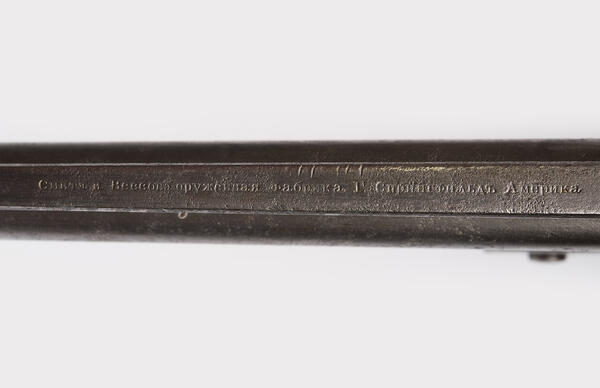Revolvers that were developed during the Crimean War demonstrated their clear advantage over single-shot percussion cap pistols in close combat. From then on, revolvers from various foreign manufacturers gradually became more widespread in the Russian army. In the late 1860s, an American firearm company founded by Horace Smith and Daniel Wesson actively sought orders from abroad. The US Army purchased Colt revolvers at that time. After reviewing the 4.2-line (10.67 mm or .44 Russian) caliber revolver presented by Smith & Wesson, it was decided to equip the Russian army with it.
The revolver on display was produced in the United States for Russia starting in 1871 and was then modified several times. In 1873, the Russian model of the revolver received a gold medal at the international exhibition in Vienna. The first contract provided for the delivery of 20,000 weapons and a total of 250,000 units were purchased from the United States. With the introduction of these revolvers, percussion cap pistols were eventually removed from the arsenal of Russian troops.
The Russian army used Smith & Wesson revolvers of three different models, which varied primarily in barrel length. At that time, the revolver was regarded as one of the finest. In two minutes, a shooter could fire up to 24 rounds. Smith & Wesson revolvers were issued to infantry officers, field sergeants, military musicians, drummers, and buglers, as well as cavalry soldiers such as the uhlans and hussars.
The weapon proved its worth during the Russo-Turkish War of 1877–78 and in campaigns in Central Asia. In 1886, production of Smith & Wesson revolvers began at the Tula Arms Factory. In 1895, it was replaced by a revolver designed by the Belgian engineer Nagant.
The revolver on display is a modification of the
1872 model. It has a six-round cylinder that uses centerfire ammunition (that
is, the cartridge’s primer is located at the center of the base of its casing),
and a single-action trigger — thus, the hammer has to be manually cocked prior
to each shot. The “Russian” version of the revolver has two distinguishing
features: a “heel”, which is a protrusion on the upper part of the back of the
grip, and a “spur” — a rest for the middle finger below the trigger. They made
it easier to hold the weapon more securely in the hand. Both of these features
are present in the museum’s exhibit.




